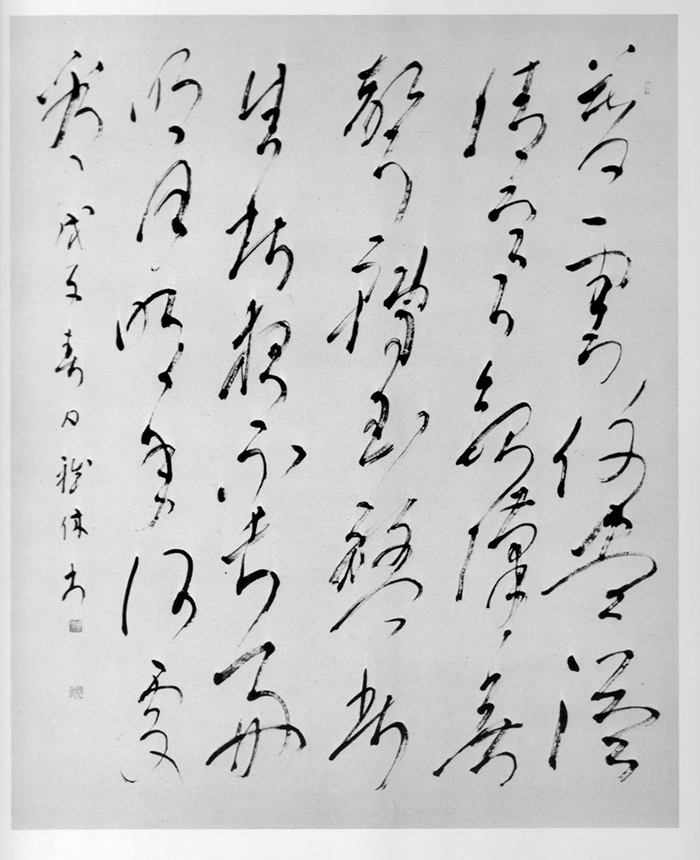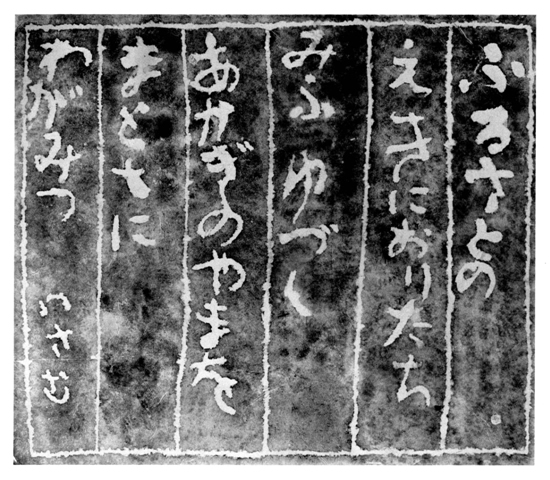Brothers Gakyu Osawa (1890-1953) and Chikutai (1902-1955) left behind a trail of spectacular activities like a meteor at the dawn of modern calligraphy. Their work shook the traditionalist world of calligraphy at the time and at the same time breathed new life into the world of calligraphy. While pursuing the formative qualities of calligraphy, their work was also rooted in a spirit of tireless scholarship, including the reproduction of classical works and the study of poetry.
(Extracted from the leaflet of the ‘Gakyu Osawa and Chikutai Brothers and their disciples’ exhibition at the NARITASAN MUSEUM OF CALLIGRAPHY, 1999).
This web gallery presents numerous calligraphic works and essays by Gakyu Osawa and Chikutai brothers, as well as critiques by Shiko Munakata, Takahiko Ifukube, Shunkei Iijima, Sakon Sou, Shotaro Miyake, Akira Nagoya and Toshiro Takahashi.

大 澤 雅 休
Gakyu Osawa (real name: Masayasu) 1890-1953
Born in 1890 in Shibasaki, Ohrui Village, Gunma-District, Gunma Prefecture (now Shibasaki, Takasaki City, Gunma Prefecture), Gakyu became a substitute elementary school teacher in 1916 and worked in primary education until his retirement. 43 years old, he began calligraphy under Tenrai Hidai, a well-known calligrapher of Chinese characters. Gakyu, who was passionate about peasant literature and spelling education, came to realize that the essence of "writing" ultimately lay in the physical movement that formed each dot and stroke of a character. In 1938, he and his younger brother Chikutai founded a calligraphy association, Heigen-sha, and in 1948, he began for publishing a monthly magazine, Shogen. In September 1953, while writing a calligraphy sample for his students, he collapsed from angina pectoris and passed away.

大 澤 竹 胎
Chikutai Osawa (real name: Isamu) 1902-1955
Born in 1902, Chikutai Osawa was the brother of Gakyu, 12 years younger than him. At the age of 19, he admired Takuboku Ishikawa and went to Hokkaido, where he worked as a substitute teacher in Rubeshibe. At that time, he played the mandolin, sang songs, and enjoyed a free life. In 1927, he followed Gakyu to Tokyo, where he studied under Chikudo Takatsuka who was famous artist for Kana calligraphy in Japan in 1929. Before the war, as an executive staff under Chikudo, he opened many kana calligraphy classes in the Meguro area. Since that time, Chikutai's works have been called "Chikutai kana" because he did not use variant kana (Hentai Gana) and not showed a continuous pattern in his works. In 1955, he died suddenly of a heart attack.

大 澤 雅 休
Gakyu Osawa (real name: Masayasu) 1890-1953
Born in 1890 in Shibasaki, Ohrui Village, Gunma-District, Gunma Prefecture (now Shibasaki, Takasaki City, Gunma Prefecture), Gakyu became a substitute elementary school teacher in 1916 and worked in primary education until his retirement. 43 years old, he began calligraphy under Tenrai Hidai, a well-known calligrapher of Chinese characters. Gakyu, who was passionate about peasant literature and spelling education, came to realize that the essence of "writing" ultimately lay in the physical movement that formed each dot and stroke of a character. In 1938, he and his younger brother Chikutai founded a calligraphy association, Heigen-sha, and in 1948, he began for publishing a monthly magazine, Shogen. In September 1953, while writing a calligraphy sample for his students, he collapsed from angina pectoris and passed away.

大 澤 竹胎
Chikutai Osawa (real name: Isamu) 1902-1955
Born in 1902, Chikutai Osawa was the brother of Gakyu, 12 years younger than him. At the age of 19, he admired Takuboku Ishikawa and went to Hokkaido, where he worked as a substitute teacher in Rubeshibe. At that time, he played the mandolin, sang songs, and enjoyed a free life. In 1927, he followed Gakyu to Tokyo, where he studied under Chikudo Takatsuka who was famous artist for Kana calligraphy in Japan in 1929. Before the war, as an executive staff under Chikudo, he opened many kana calligraphy classes in the Meguro area. Since that time, Chikutai's works have been called "Chikutai kana" because he did not use variant kana (Hentai Gana) and not showed a continuous pattern in his works. In 1955, he died suddenly of a heart attack.






